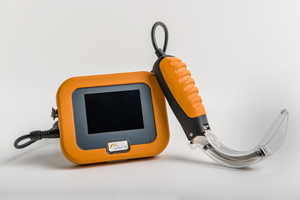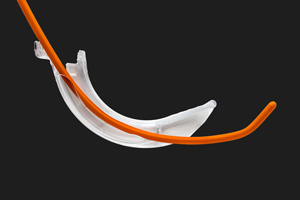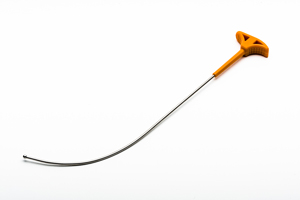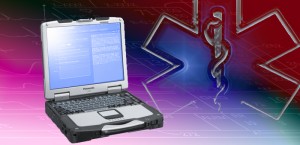The CoPilot VL®
It has finally arrived. The next generation of video intubation tools is here, and I got my hands on one of the first.
So were do I get the CoPilot VL®?
| Learn more about the CoPilot VL for EMS at Medsouth1.com |
 |
It has finally arrived. The next generation of video intubation tools is here, and I got my hands on one of the first.
| Learn more about the CoPilot VL for EMS at Medsouth1.com |
 |
Tags:gear, intubation, patient care
Posted in EMS Stuff Reviewed, Featured, slider | 3 Comments »

It has finally arrived. The next generation of video intubation tools is here, and I got my hands on one of the first.
1st generation video scopes
Five years ago the EMS world was introduced to the GlideScope. This mythological end all tool was only whispered about by most EMS providers due to the 15K price tag. What the GlideScope did was simply put a video camera on a laryngoscope and a separate view screen . The idea here was that in a difficult airway situation were getting a direct view of the anatomy was difficult or near impossible we had a camera to guide us. This was quite revolutionary and everyone wanted one.
Next came the competition. Some versions were a simple redesign at a lower price while others made modifications such as including the view screen on the handle of the scope. These first generation video scopes all have one thing in common, the actual process of intubating was the same as before.
Next up, the CoPilot VL® (video laryngoscope)
the first and only generation 2 video laryngoscope.


After you are finished intubating there is a button on the handle of the scope that releases the blade into the bio bag. Grab slide another blade on and you are ready to go. No cleaning of this equipment unless it was a truly messed up call. So I guess there is no need for all those autoclaves in our stations, LOL.
The other accessories include a power cord, IV pole clamp, and a handy bag. The unit will run for 2 hours before you need to plug it in. You could intubate every patient in a shift before you need to recharge. The IV clamp will probably end up in the EMS junk drawer. This was intended for hospital use.
The CoPilot VL® was not a redesign of previous units but a redesign of the intubation process addressing the known issues.
The curvature of the blade on the CoPilot VL® is set perfectly. You simply drop the blade and you are looking right up at the cords. Slide your Bougie down the port, click click click and your in. It really is that simple.
No matter how revolutionary and cool a new tool is there is one main factor that will be a deal breaker and that is price. Most of us working the ambulance have never seen a GlideScope in real life due to the $15,000 price tag. However the CoPilot VL® is nicely priced at $2999.00. The disposable blades will run you $10.00 each.
No need to remove a C-Collar / no more manipulating anatomy
Absolutely. This company carries the slogan “First time, every time”. I do believe it. You really have to use it only once to see just how easy it makes intubation. Even an EMT-Basic can do it. (LOL just kidding guys)
First time, every time
| Learn more about the CoPilot VL for EMS at Medsouth1.com |
 |
Tags:gear, intubation, patient care, productivity
Posted in EMS Stuff Reviewed, Featured, slider | 2 Comments »

One source states that every negligence case in the last 30 years has been decided on its documentation. (more…)
Tags:liability, patient care, refusal
Posted in Featured, Patient Care | 2 Comments »
Tags:liability, patient care, refusal
Posted in Featured, Patient Care | 4 Comments »
The first question that must be answered before accepting a patient’s refusal is whether or not the patient can refuse. Most of the time this is simple enough but there are some special considerations that if addressed and documented will give added protection to the provider and ems agency in court.
As with any other patient we assess we want to know if the patient’s mental status is altered. In addition to determining if the patient is alert and oriented x4, especially when dealing with a possible head injury or intoxicated patient, we need to ensure the patient’s short term memory is intact by asking the patient to remember three items. Before accepting the refusal have the patient repeat these things back to you. Court cases have shown that this level of assessment does not quite finish the job. The patient’s level of awareness needs to be further evaluated.
The courts want to know if the paramedics determined that the patient actually knew what was going on and was able to make an informed decision.
The patient needs to understand the nature of the condition and risks of refusing care as well as the benefits of being evaluated at the ED. This step can be easily determined. Inform the patient of the condition and describe the risks of refusing care as well as the benefits to being evaluated in an emergency room which should include abilities of the ED that you can not perform such as labs and CT. Ask the patient to repeat this back to you in his own words. This demonstrates that the patient is aware of the situation and possible outcomes. If the patient can not do this then you should continue patient care under implied consent. If the patient does pass these tests, even with ETOH on board, then the patient has the right to refuse care.
Practical Tip: EXPLOIT uncertainty! Many patients are unsure about whether or not to go to the hospital, and that uncertainty can be used to your advantage in advising the patient to obtain the care they need.
The advise in this section is intended for those working in states that do not have laws that address refusals and intoxicated patients. Not having laws to protect the provider means that we should take extra care to avoid a lawsuit. Research your local laws to determine just how covered you are.
When dealing with a possibly drunk patient think of their mental status as either being altered or not. The odor of ETOH alone does not mean the patient can no longer refuse care. If you suspect the patient to be intoxicated but not altered then keep these caveats in mind.
The final draft of our protocol addresses the possibly intoxicated patient. Specific criteria are outlined that if any are true then assume implied consent to treat and transport, utilizing the police if needed.
You are called to the home of an elderly female with hip pain. The family tells you they have a signed power of attorney and want her transported. The patient however flat out refused to go anywhere. You check the patient out and try to convince her to go to the hospital but the patient signs the refusal. The patient’s condition deteriorates and the family takes her to the ER where a hip fracture is found. The family then sues you. This was a real court case and you can read the JEMS article here. The result was that the court decided in favor of the medics. Even though a patient has signed a power of attorney does not mean they can no longer make decisions for themselves. Document everything and follow your company’s protocols.
The legal age of a patient to make an informed decision about his health care will vary from state to state. If the patient is not old enough to make this call then until the patients legal guardian is contacted treat and transport under implied consent. One possible caveat to this is an emancipated minor.
If you are still unsure if you should be transporting a patient against his will contact a supervisor or medical control.
In my area the doctors here will not tell you it is ok not to transport the patient. Instead we use online medical control for advise in talking the patient into going to the hospital. Document this as it will add protection in court.
Tags:liability, patient care, refusal
Posted in Featured, Patient Care, slider | 4 Comments »
Recently I assisted my company in updating our protocols. One topic I covered was the patient refusal. I wanted a new perspective on the matter with the goal of decreasing the risk of litigation as well as decreasing the total number of refusals. My approach was to first see how others were tackling refusals. I researched the protocols of other services and read many articles on the topic. It was obvious that the industry standard left grey areas that needed to be addressed. I then looked to the courts to answer some of the remaining questions by researching every court case I could find where someone first refused care and later sued the provider. With the help of our medical director this information was compiled to produce our new Informed Patient Refusal Protocol. This is a multi part blog series where I will break down the important topics realized from this project.
You are dispatched to a residence for a ‘sick person’. As you arrive you enter the home after walking by 4 vehicles and multiple family members. You find the patient sitting next to a packed suitcase smoking a cigarette. The patient tells you he has had a cough for some time and wants some medicine. The patient denies SOB. You check vitals, ecg, and everything else in your assessment arsenal and only note the cough. You toss in an IV and lead a caravan of vehicles with their flashers on to the hospital.
I think everyone in EMS can relate to this and dreams of the ability to tell the patient to jump in your car and drive yourself the 1 mile to the hospital. So why don’t more services allow this? One group studied found prehospital provider refusal of transportation, as opposed to patient refusal of a transportation, accounted for 73% of the post refusal hospital admissions. Which means that to allow ground crews to determine if a patient should not be transported to the hospital would increase the risk of litigation / out of court settlement by 270%. In the future I would like to see the solution to this to be in the form of the advanced paramedic program where medics can talk to online medical control and write simple prescriptions for coughs and paper cuts but until then most services choose to take up that lovely old saying “you call, we haul”.
Tags:liability, patient care, refusal
Posted in Featured, Patient Care, slider | 3 Comments »
© Copyright 2024 | emsops.com. All rights reserved. emsops.com is proudly powered by WordPress
